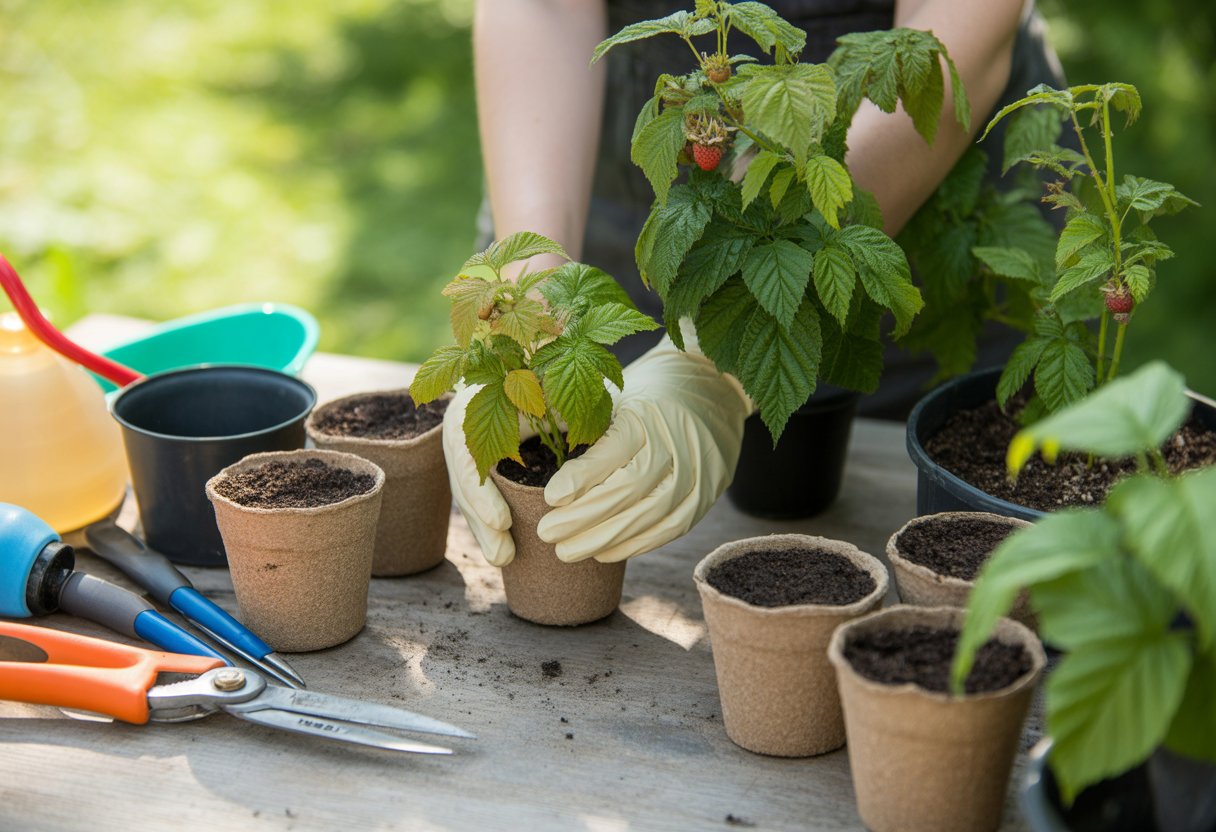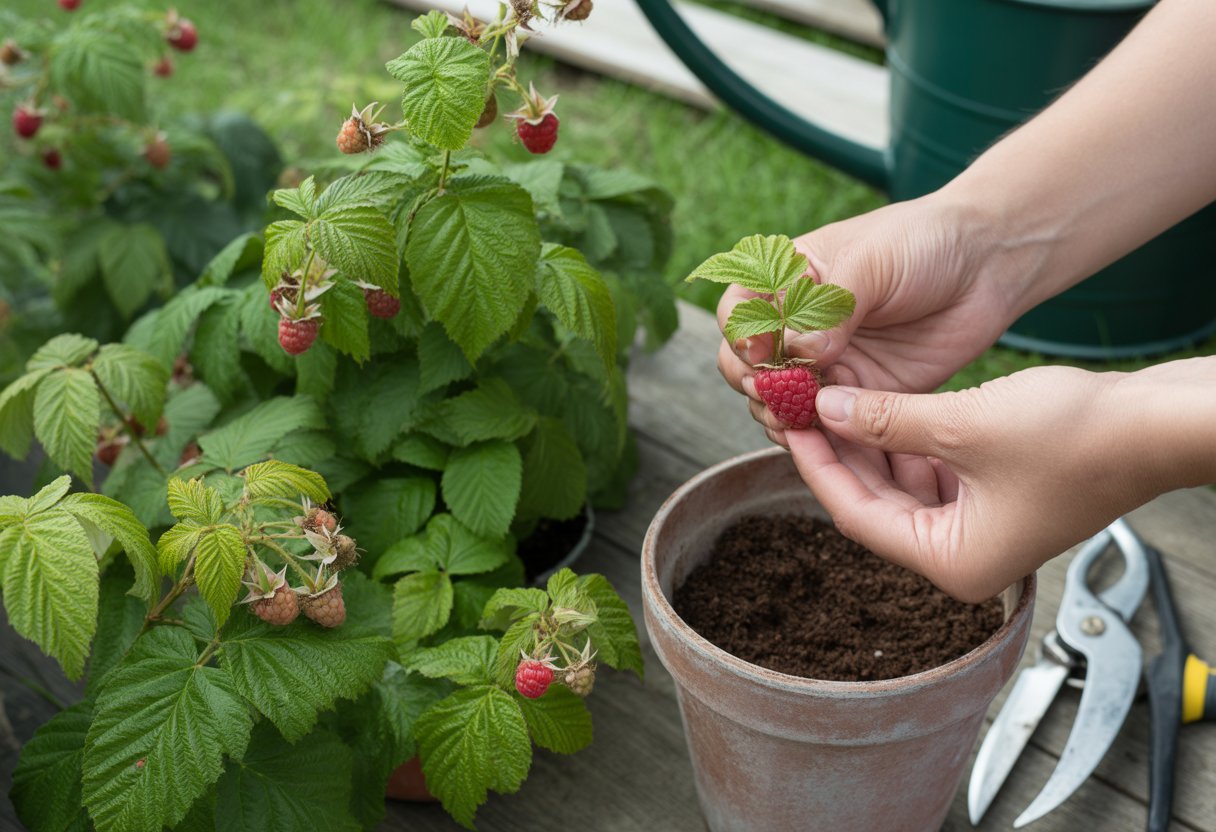How to Propagate Native Raspberry: Effective Methods for Healthy Growth
Propagating native raspberry plants is a practical, budget-friendly way to expand your garden. The best method for native raspberries is usually root cuttings or tip layering, which let you grow new plants from the roots of existing ones.
These simple approaches help you keep the plant’s natural traits and encourage healthy growth.

Raspberries love to spread underground. If you dig up and replant parts of the root system, you’ll get sturdy new raspberry plants that fit right in with your local conditions.
If you know how to propagate native raspberries, you’re not just saving money—you’re supporting sustainable gardening and keeping local varieties alive.
Understanding Native Raspberry Propagation
To propagate raspberries successfully, you need to know the different types, how they grow, and how to pick strong parent plants. These things affect how fast your new plants settle in and start making fruit.
Raspberry Varieties
Most native raspberries are in the genus Rubus, like Rubus idaeus found in North America. These species vary in fruit size, flavor, and how tough they are.
Some types are perennial, so they’ll fruit every year. Others are biennial, which is a bit less predictable.
Gardeners usually split cultivated raspberries into summer-bearing and everbearing kinds. Summer-bearing types give fruit on second-year canes—those are called floricanes.
Everbearing raspberries fruit on both primocanes (first-year canes) and floricanes, so you get two harvests a year.
Knowing what kind you have helps you pick the right propagation method and timing. Native varieties can be easier to care for, but their disease resistance and growth habits might not match up with hybrids.
Growth Habits and Plant Biology
Raspberries send up new shoots from their roots every year. Primocanes are the fresh, first-year canes that focus on leafy growth. Floricanes are the older, second-year canes that flower and fruit.
Native raspberry plants can spread by seed, but they’re just as happy to make new plants from suckers or by tip layering. Suckers pop up from roots near the parent plant and can be dug up and moved.
Tip layering is a neat trick—just bend a primocane down so the tip touches the soil, and it’ll root on its own.
Pruning out dead floricanes helps new primocanes grow strong. This cycle keeps the plant healthy and productive, which is exactly what you want.
Choosing Healthy Parent Plants
If you want strong new raspberries, start with healthy parent plants. Look for plants with no pests, no disease, and no signs of stress like wilting or weird discoloration.
Pick plants with vigorous primocanes and solid roots. Multiple shoots and no fungus? Even better.
Take cuttings or divide suckers from healthy plants for the best results. Avoid anything with root rot or obvious nutrient problems. Healthy parents mean fewer headaches later.
Propagation Methods for Native Raspberry
You’ve got a few ways to propagate native raspberries, depending on what you want and what your garden’s like. You can start from seeds, use cuttings, or transplant young shoots.
Each method has its own timing and care requirements.
Propagating by Cuttings
To propagate by cuttings, take healthy, semi-hardwood stems from the parent plant. Aim for 4-6 inch cuttings in late spring or early summer.
Snip off the lower leaves and dip the base in rooting hormone if you like—this helps the roots get going.
Stick the cutting in well-drained soil or a sterile rooting mix. Keep things moist and out of direct sun. Roots usually show up in about 4-6 weeks.
This method gives you plants that are basically clones of the parent. If you want to keep things organic or stick with a favorite variety, this is the way to go.
Growing Raspberries from Seed
If you’re patient, you can grow raspberries from seed. Start by collecting ripe berries and getting the seeds out.
Clean seeds need a cold spell—pop them in the fridge at 1-5°C for 2-3 months to break dormancy. After that, sow them in a seed-starting mix about 1/8 inch deep.
Keep the seedlings moist, warm (18-21°C), and in good light. Germination can take a couple of weeks, sometimes longer.
Growing from seed gives you more genetic variety, but you’ll wait longer for fruit. It’s a good approach if you’re into breeding or want to preserve wild types.
Transplanting Suckers or Shoots
Transplanting is straightforward. Dig up young suckers or shoots that have roots, usually in early spring or fall when the plant isn’t super active.
Be gentle so you don’t break the roots. Move the sucker to prepared soil with good drainage and lots of organic matter.
Water well and mulch to hold moisture. This method is a solid way to grow your patch and keep the same plant traits.
Essential Growing Conditions and Care

Native raspberries need certain conditions to really thrive. The right soil, light, temperature, watering, and a bit of support all make a big difference.
Soil Preparation and pH
Raspberries do best in well-drained soil with lots of organic matter. They like it slightly acidic to neutral—shoot for a pH between 5.5 and 6.5.
If your soil’s too alkaline, the plants might struggle to get nutrients.
Mixing in compost or aged manure before planting helps with fertility and texture. Steer clear of heavy clay that holds water—raspberries hate soggy roots.
Test your soil pH. If you need to tweak it, use sulfur to lower pH or lime to raise it. Consistent soil conditions mean stronger roots and healthier plants.
Light, Temperature, and Air Circulation
Native raspberries want full sun—at least 6-8 hours a day. Less sun usually means smaller berries and fewer of them.
They’re happiest between 60°F and 75°F (15°C – 24°C) during the growing season. They can handle cooler temps, but long stretches above 85°F can stress them out.
Give them plenty of space for air to move around. Good air flow keeps fungal diseases at bay. Don’t cram them in; crowded plants get too humid and sickly.
Watering and Fertilizing
Watering consistently is key, especially when they’re flowering and fruiting. Aim for 1 to 2 inches of water per week, and water at the base to keep leaves dry.
Mulch helps hold in moisture and keeps roots cool. Avoid overwatering—soggy soil leads to root problems.
Fertilize with a balanced mix like 10-10-10 (N-P-K) in early spring. After the first harvest, you can feed them again to boost growth. If you prefer, compost tea or fish emulsion works well too.
Support and Trellising
Trellising makes a big difference. Native raspberries benefit from support to keep canes upright and harvesting easy.
A simple two-wire trellis, wires about 3 feet apart, does the trick. The lower wire holds primocanes, the upper wire supports floricanes.
Tie up the canes so they don’t break or flop over. Good support helps with air flow and makes pruning a lot simpler.
If you skip trellising, expect canes to sprawl and get tangled or damaged. It’s worth the effort for healthier plants and better fruit.
Ongoing Raspberry Plant Maintenance

Taking care of native raspberries means paying attention to their shape, keeping pests in check, and harvesting at the right time. Good maintenance leads to stronger plants and bigger harvests down the line.
Pruning for Healthy Growth
Raspberries need annual pruning to get rid of old canes and make space for new ones. After you pick the fruit, cut those spent canes right down to the ground.
This helps prevent diseases like anthracnose from taking hold. Thin out new shoots early so air and light can get in—this lowers the risk of fungal problems.
Leave only the strongest canes, spaced about 6 inches apart. Use sharp, clean tools and wipe them down between cuts so you don’t spread disease.
Prevention of Pests and Diseases
Keep an eye out for common pests like aphids and spider mites. Natural predators or insecticidal soap can usually handle them without hurting your plants.
Fungal diseases thrive in damp, crowded spots. Prune out dead or sick canes fast, and don’t water from overhead.
Give your plants space, rotate crops if you can, and clear away old plant debris to keep diseases in check.
Harvesting and Post-Propagation Care
Pick raspberries only when they’re fully ripe. They should come off with just a gentle twist—no tugging required.
If you harvest often, you’ll probably get more fruit over time. Use clean containers so you don’t crush the berries or spread anything nasty.
After you’ve finished picking, clear away any leftover fruit. Cut back old canes to help the plant get ready for its next growth cycle.
Try spreading mulch around the base. It’ll keep moisture in and help block out weeds, which is great for the roots.
Feed your plants regularly with a balanced fertilizer. This keeps them healthy and growing strong.
